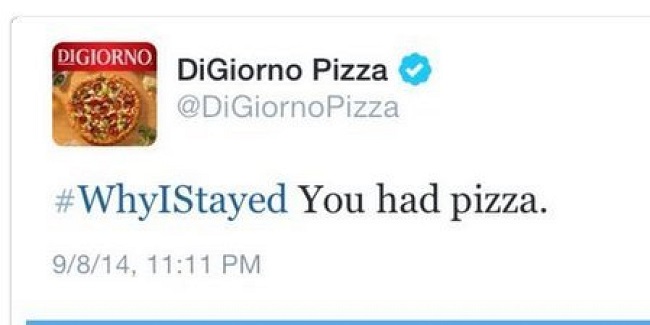Author: Joshua Nite / Source: Online Marketing Blog – TopRank®

In late 2014, the hashtag #WhyIStayed was trending on Twitter. Frozen pizza slinger DiGiorno, known for being snarky and clever on social media, wanted to join the fun:

There was just one problem: #WhyIStayed started in response to a video of domestic abuse. Women used the hashtag to tell their own story of abuse and talk about the societal pressures that led them to stay with their abusers.
At best, DiGiorno looked clueless. At worst, it looked like they were making light of a very serious issue. All they wanted was a little brand visibility…and they got it, but not in the way they were hoping.
Hashtags are an integral part of Twitter and Instagram (and Facebook, to a much lesser extent). As such, they should be part of our social media marketing on each platform. But as DiGiorno and many other brands have shown, it’s not enough to look at the trending tags and hop on board. Marketers need to understand what hashtags are for and how our audience is using them before we jump in.
Here are the #fundamentals you need to avoid invisibility or embarrassment with hashtags.
#History
Hashtags started as a feature on IRC (Internet Relay Chat) channels back in 1988, when the internet still ran on steam turbine power. The “#” in front of channel meant that it was available for users across the internet, not just on a local area network.
Twenty years later, IRC fans who were early Twitter adopters proposed using the symbol to help classify common topics or groups. Twitter itself didn’t officially recognize hashtags for two more years. In 2009, the site started automatically hyperlinking hashtags to search results.
Facebook added hashtags in 2013, but they don’t see as much use on the platform. By contrast, Facebook-owned Instagram practically runs on hashtags. It’s not unusual to see a post with a four-word captioned followed by a paragraph of tags: #NoFilter #WokeUpLikeThis #BeachLife #SanDiego #ChihuahuaLove. Clicking any of the tags leads to a custom feed of images with the same tag, much like Twitter’s search functionality works.
#WhatHashtagsAreNot
Hashtags began as a way to categorize information for future searchers, much like the category or topic tags on a blog. In that case, using the right hashtags is…
Peter Bordes Jr
Founder & Managing Partner Trajectory Ventures. Lifetime entrepreneur, CEO, Board Member, mentor, advisor and investor.
Obsessed with the infinite realm of possibility in disruptive innovation driving global digital transformation in technology, cloud-based infrastructure, artificial intelligence, data, DevOps, fintech, robotics, aerospace, blockchain and digital media and advertising.

